The Junior Detective Badge is a fun and educational program designed for young participants to develop critical thinking and observation skills. It encourages teamwork, problem-solving, and creativity while introducing essential detective techniques. The badge is part of the Junior Girl Scout program, focusing on skill development through engaging activities. Participants learn to communicate in codes, analyze fingerprints, and solve mysteries, fostering a sense of accomplishment and curiosity. This badge is more than just recognition—it’s a gateway to building lifelong skills in a playful and interactive way.
1.1 Purpose of the Junior Detective Badge
The purpose of the Junior Detective Badge is to empower young participants with essential skills like critical thinking, observation, and problem-solving. It aims to foster curiosity, creativity, and teamwork while introducing them to detective techniques. By completing activities such as code-breaking, fingerprint analysis, and mystery-solving, participants gain confidence and a deeper understanding of investigative processes. The badge serves as a fun, interactive way to develop lifelong skills, encouraging active learning and collaboration. It is designed to be both educational and engaging, helping juniors grow into capable and thoughtful individuals.
1.2 Significance of the Badge in Skill Development
The Junior Detective Badge plays a crucial role in fostering essential life skills such as critical thinking, observation, and problem-solving. It encourages participants to develop creativity and analytical abilities while engaging in fun, detective-themed activities. By mastering skills like code-breaking and fingerprint analysis, juniors build confidence and improve their attention to detail. These experiences also enhance teamwork and communication, preparing them for collaborative challenges. The badge’s focus on hands-on learning makes it an effective tool for skill development, helping young individuals grow into capable, curious, and independent thinkers.
1.3 Structure of the Badge Requirements
The Junior Detective Badge requirements are structured into five key steps, each designed to build specific skills. Step 1 focuses on observation, teaching participants to notice details. Step 2 introduces coding and decoding, enhancing communication skills. Step 3 explores fingerprinting, combining science with fun. Step 4 involves detective science experiments, fostering curiosity. Step 5 challenges participants to solve a real mystery using gathered clues. The requirements are progressive, ensuring a comprehensive learning experience. Materials and guides are provided to support each activity, making the badge achievable through hands-on engagement and creative problem-solving.
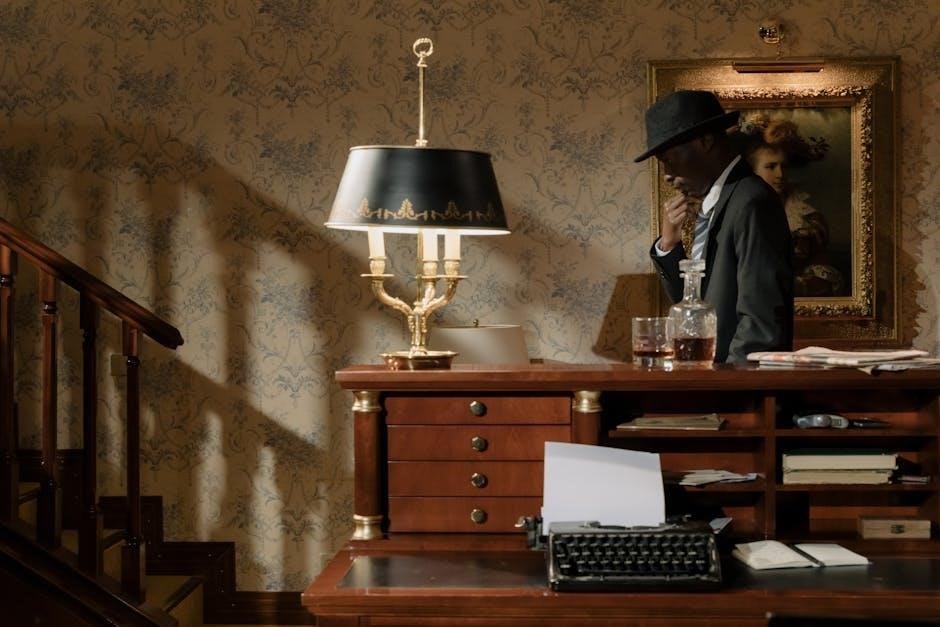
Core Requirements for Earning the Badge
Earning the Junior Detective Badge involves practicing observation, communicating in code, fingerprinting, conducting science experiments, and solving a real mystery through clues.
2.1 Practice the Power of Observation
Practicing the power of observation is a fundamental step in earning the Junior Detective Badge. This skill involves training oneself to notice details in the environment, people, and objects. Participants learn to sharpen their awareness by engaging in activities such as identifying specific details in images or scenarios. Observation exercises help develop critical thinking and attention to detail, essential for detective work. By mastering observation, juniors can better analyze clues and solve mysteries effectively. This skill is a cornerstone of detective training, preparing young detectives to excel in future investigations.
2.2 Communicate in Code
Communicating in code is a thrilling part of the Junior Detective Badge requirements. Participants learn to encode and decode messages, using techniques like substitution ciphers, Morse code, or secret alphabets. This skill helps juniors understand how to send and receive hidden information, just like real detectives. Activities include creating cipher wheels, decoding puzzles, and crafting personalized code necklaces. By mastering these methods, juniors develop problem-solving abilities and teamwork skills, essential for solving mysteries. This fun and interactive learning experience makes communication exciting and prepares young detectives for future investigations with a strong foundation in secure messaging.
2.3 Fingerprinting for Fun and Investigation
Fingerprinting is a fascinating activity that introduces juniors to forensic science basics. Participants learn to lift and analyze fingerprints, discovering how unique patterns like arches, loops, and whorls can identify individuals. Using simple materials like ink pads and paper, they practice capturing prints and comparing them. This hands-on experience teaches the importance of fingerprints in real-world investigations. It’s both educational and entertaining, sparking curiosity about forensic techniques while fostering observation and attention to detail. This activity prepares young detectives to understand how small details can solve big mysteries, making it a cornerstone of the Junior Detective Badge program.
2.4 Try Out Detective Science
Detective science introduces juniors to the exciting world of forensic investigations. Through hands-on experiments, they explore techniques like DNA extraction, analyzing footprints, and testing unknown substances. Simple yet engaging activities, such as creating homemade lava lamps or growing crystals, demonstrate scientific principles. These experiments encourage critical thinking and problem-solving, essential tools for aspiring detectives. By conducting these fun experiments, participants gain a deeper understanding of how science applies to real-life mysteries, making this step both educational and enjoyable. It fosters curiosity and prepares them to approach challenges with a scientific mindset, enhancing their detective skills.
2.5 Follow the Clues to Solve a Real Mystery
This step challenges juniors to apply their detective skills by solving a real mystery. Participants collect and analyze clues, interview witnesses, and piece together evidence to crack the case. Activities include decoding messages, identifying fingerprints, and following trails of hidden hints. The mystery is designed to simulate real-life detective work, encouraging teamwork and problem-solving. By presenting their findings, juniors demonstrate their understanding of investigative techniques and critical thinking. This engaging activity fosters creativity, sharpens observational skills, and provides a sense of accomplishment as they uncover the truth.
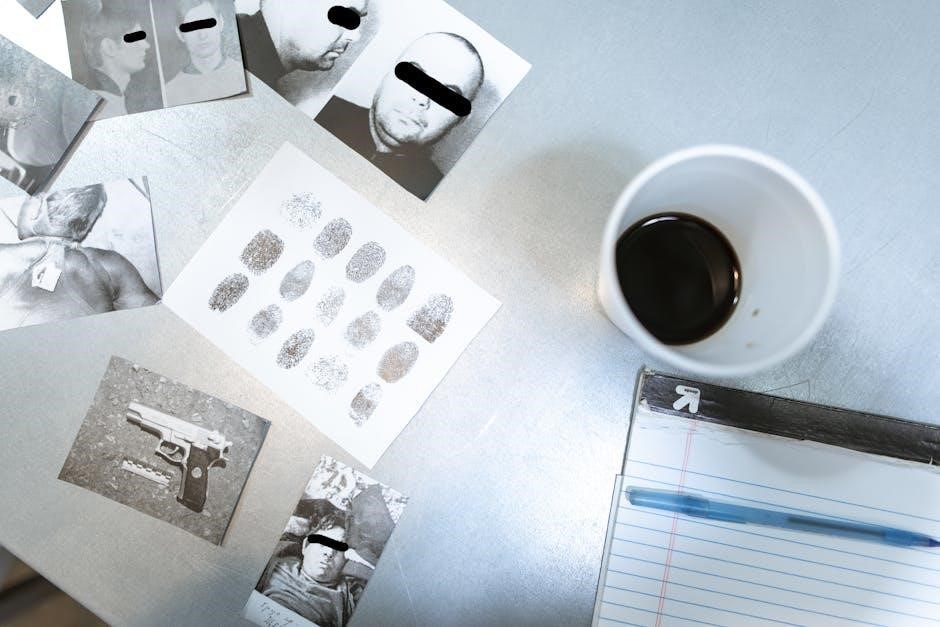
Detailed Steps for Each Requirement
This section breaks down each requirement into clear, engaging activities. Juniors practice observation, decode messages, analyze fingerprints, conduct science experiments, and solve mysteries through structured steps;
3.1 Step 1: Developing Observation Skills
Developing observation skills is the foundation of detective work. Juniors learn to carefully watch and describe details in their environment; Activities include the “Look and Remember” game, where items are observed and recalled from memory. Participants practice noting colors, shapes, and textures to enhance their awareness. They also observe people and situations, recording their findings in a journal. This step encourages patience, focus, and the ability to notice subtle details, essential for solving mysteries. By mastering observation, juniors build a keen eye for clues, preparing them for more complex detective tasks ahead.
3.2 Step 2: Learning to Encode and Decode Messages
Learning to encode and decode messages introduces juniors to the art of secret communication. Using simple materials like paper strips, glue, and scissors, participants create their own codes, such as ciphers or invisible ink. They practice sending and decoding messages, fostering problem-solving skills and teamwork. This step teaches the basics of cryptography, encouraging creative thinking and attention to detail. By mastering these techniques, juniors develop essential detective skills, preparing them to tackle more complex challenges in their investigative journey. This activity is both fun and educational, making it a highlight of the badge program.
3.3 Step 3: Understanding Fingerprint Analysis
Fingerprint analysis is a core detective skill that captivates juniors with its scientific and artistic aspects. Participants learn to create and identify different fingerprint patterns, such as loops and whorls, using ink pads and paper. This step introduces the concept of unique identification, emphasizing how fingerprints can solve mysteries. Activities include comparing prints and understanding their role in investigations. By engaging in hands-on exercises, juniors develop observational skills and gain a deeper appreciation for forensic science. This step transforms a complex topic into a fun, educational experience, making it a memorable part of the badge journey.
3.4 Step 4: Conducting Science Experiments
Conducting science experiments is an exciting part of the Junior Detective Badge, blending fun with learning. Activities like DNA extraction using household items or creating Morse code necklaces introduce basic scientific concepts. Participants also explore chromatography to separate ink colors, learning about chemical properties. These experiments foster critical thinking and curiosity, connecting science to detective work. By engaging in these hands-on tasks, juniors develop problem-solving skills and a deeper understanding of the scientific methods used in investigations. This step makes science accessible and enjoyable, inspiring a love for STEM while advancing detective skills.
3.5 Step 5: Solving a Mystery Through Clues
Solving a mystery through clues is the final step in earning the Junior Detective Badge, where participants apply all they’ve learned. They analyze evidence, decode messages, and piece together facts to crack a case. This step encourages deductive reasoning and sharpens problem-solving skills. Juniors can even create their own mystery, testing their ability to gather and interpret clues. By solving a real or fictional case, they gain confidence in their detective abilities and understand the importance of teamwork in uncovering the truth. This hands-on experience makes learning exciting and rewarding, preparing them for future challenges.
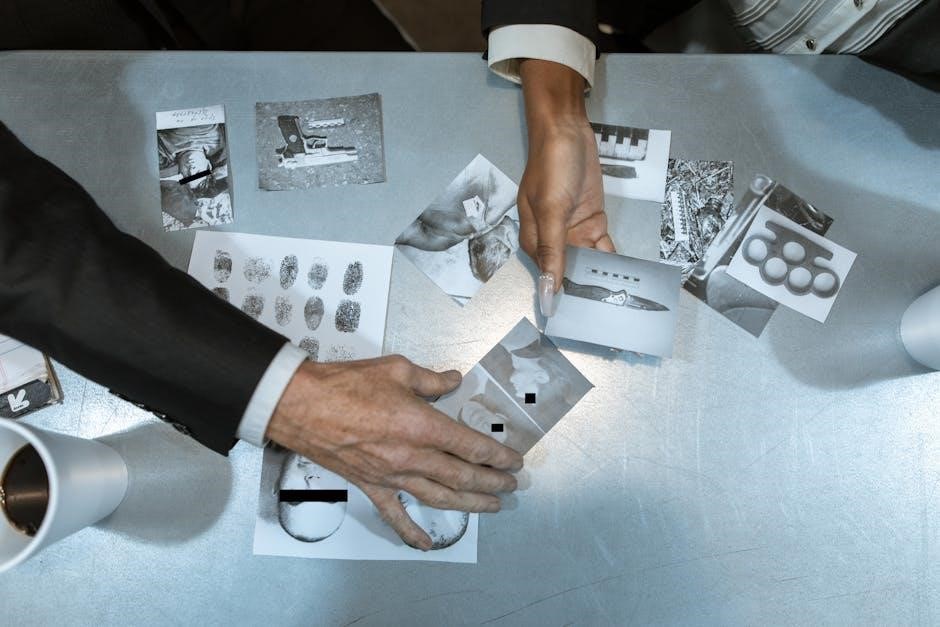
Materials and Resources Needed
Pens, pencils, paper, magnifying glasses, fingerprinting kits, code-breaking tools, and detective-themed worksheets are essential. Additional supplies like pipettes and glue may be required for specific activities.
4.1 List of Required Materials
To complete the Junior Detective Badge requirements, gather essential supplies like pens, pencils, paper, magnifying glasses, and fingerprinting kits. Include code-breaking tools, detective-themed worksheets, and activity guides. Additional items such as toilet paper tubes, scissors, glue, and pipettes are needed for specific activities. Ensure access to downloadable PDF resources, including instructions and worksheets. Optional materials like detective hats or flashlights can enhance the experience. Organize these supplies to facilitate smooth progression through each step of the badge program.
4.2 Additional Supplies for Activities
Enhance your detective experience with extra supplies like magnifying glasses for closer inspections and code wheels for cipher creation. Include craft materials such as construction paper, glue, and scissors for activity booklets. Flashlights and small notebooks can add realism to investigations. Optional items like detective hats or fake evidence bags boost engagement. Digital tools, such as code-breaking apps or online fingerprinting guides, provide interactive learning opportunities. These additional supplies enrich the program, making activities more immersive and enjoyable while aligning with the badge’s educational goals.
4.3 Recommended Worksheets and Guides
To support the Junior Detective Badge activities, various worksheets and guides are available. Code-breaking exercises and fingerprint analysis templates help develop essential detective skills. Mystery-solving puzzles and observation exercises encourage critical thinking. Activity booklets with step-by-step instructions guide participants through each requirement. Additional resources include secret code wheels, clue-finding checklists, and detective-themed games. These materials are designed to enhance learning and engagement, ensuring a fun and educational experience. They align with the badge’s goals of fostering problem-solving, teamwork, and creativity in a structured and enjoyable manner.

Teamwork and Collaboration Skills
Teamwork and collaboration are vital in detective work, enhancing problem-solving and leadership abilities. Group activities foster trust, communication, and mutual respect, essential for achieving shared goals successfully.
5.1 Importance of Teamwork in Detective Work
Teamwork is essential in detective work, as it combines diverse skills and perspectives to solve complex cases. Collaborating allows individuals to cover more ground, share insights, and verify findings, ensuring accuracy and efficiency. In a team, members can specialize in different tasks, such as observation, coding, or fingerprint analysis, while working toward a common goal. This fosters trust, accountability, and creativity, leading to better problem-solving. For juniors, teamwork builds social skills and teaches the value of relying on others, preparing them for real-world challenges where collaboration is key to success.
- Enhances problem-solving through diverse perspectives.
- Builds trust and accountability among team members.
- Prepares juniors for real-world collaborative environments.
5.2 Group Projects and Activities
Group projects and activities are central to earning the Junior Detective Badge. They encourage collaboration, creativity, and problem-solving while fostering teamwork. Activities include solving mock mysteries, creating coded messages, and conducting science experiments. Participants also practice fingerprint analysis and decode clues in teams. These exercises simulate real detective work, allowing juniors to apply skills learned and work collectively toward common goals. Group challenges also promote active listening and idea-sharing, ensuring everyone contributes meaningfully. Such interactive projects make learning fun and engaging while building camaraderie among team members.
- Solving mock mysteries in teams.
- Creating and decoding secret messages.
- Conducting science experiments collaboratively.
- Practicing fingerprint analysis together.
5.3 Encouraging Active Listening and Collaboration
Active listening and collaboration are vital skills emphasized in the Junior Detective Badge program. Activities are designed to promote teamwork, where participants must listen carefully to each other’s ideas and work together to solve puzzles or decode messages. Encouraging open communication ensures everyone’s input is valued. Leaders guide discussions to foster a collaborative environment, helping juniors understand the importance of teamwork in achieving common goals. These exercises not only enhance interpersonal skills but also prepare young detectives for real-world scenarios where cooperation is key to success.
- Team members share observations and clues.
- Group discussions foster creative problem-solving.
- Active listening ensures all voices are heard.

Safety Tips and Good Citizenship
The Junior Detective Badge emphasizes safety and good citizenship through activity booklets. Participants learn to stay aware of their surroundings, secure personal items, and respect community rules while solving mysteries responsibly.
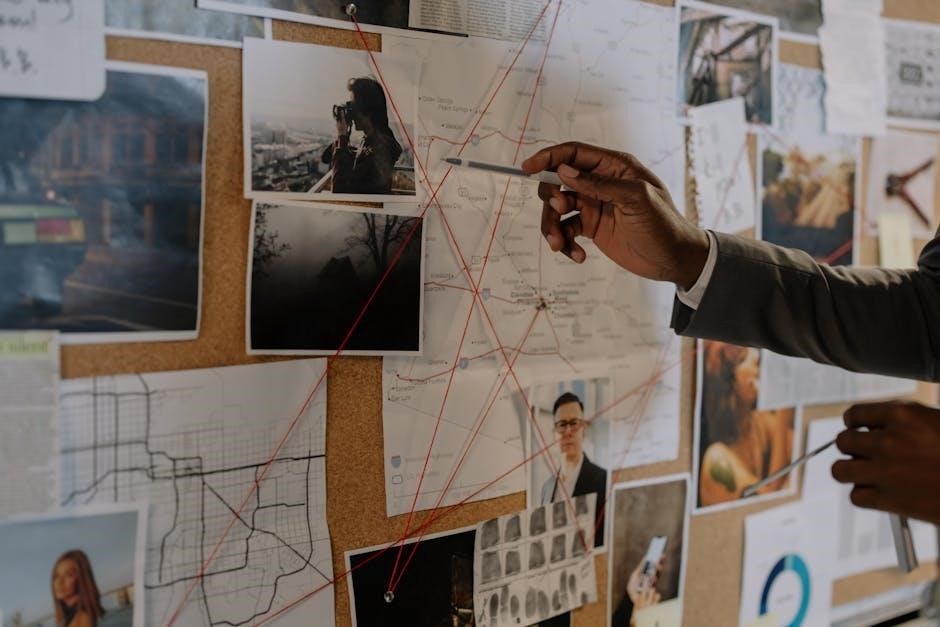
6.1 Creating an Activity Booklet
Creating an activity booklet is a key part of the Junior Detective Badge program. It includes safety tips, laws, and tasks promoting good citizenship. Participants design personalized booklets with fun detective-themed pages, including puzzles, codes, and space for notes. The booklet serves as a guide for responsible behavior during investigations, ensuring awareness of surroundings and secure handling of materials. Leaders distribute templates and art supplies, encouraging creativity while emphasizing the importance of safety and community respect. This activity fosters both practical skills and a sense of responsibility, preparing juniors for future detective adventures.
6.2 Including Safety Tips and Laws
The activity booklet includes essential safety tips and laws to ensure responsible detective work. Participants learn about handling materials safely, respecting privacy, and understanding legal boundaries. Tips cover proper conduct during investigations, such as avoiding trespassing and respecting personal property. Laws related to evidence collection and data protection are introduced to promote ethical practices. These guidelines help juniors understand the importance of responsible behavior while solving mysteries, fostering a sense of accountability and respect for rules. Safety and legal awareness are vital skills for young detectives to apply in real-world scenarios.
6.3 Tasks for Promoting Good Citizenship
The Junior Detective Badge includes tasks that foster good citizenship, such as participating in community cleanups, helping others, and promoting teamwork. These activities encourage juniors to take responsibility for their actions and contribute positively to society. By engaging in group projects and collaborative activities, participants learn the value of active listening and cooperation. The badge also emphasizes the importance of respecting rules and laws, reinforcing ethical behavior. These tasks help juniors develop a sense of duty and empathy, essential traits for responsible citizenship. The program inspires young detectives to become active, caring members of their communities.
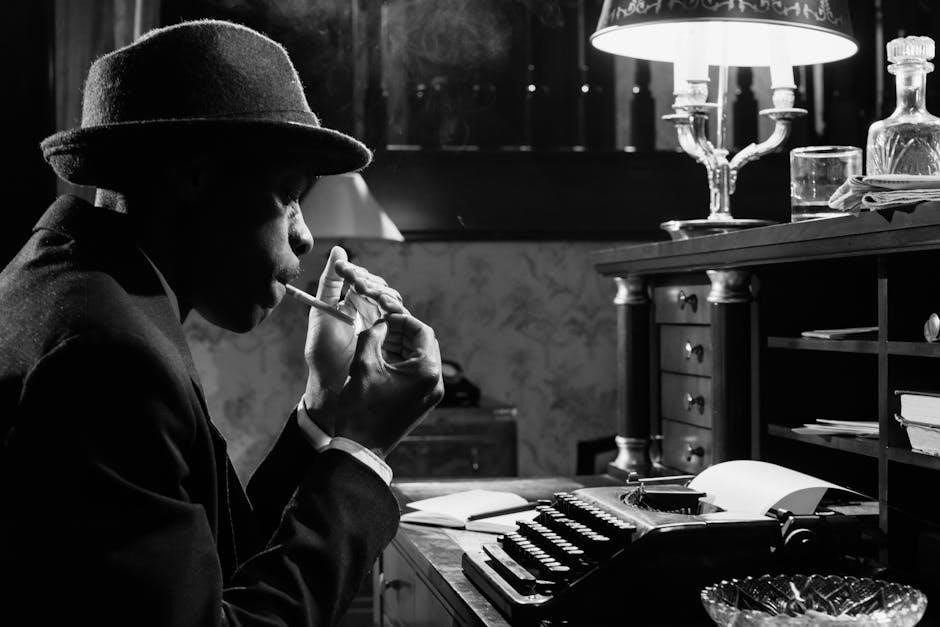
Awarding the Junior Detective Badge
The Junior Detective Badge is awarded upon successful completion of all activities, celebrating the development of critical thinking, observation, and teamwork skills. It is presented as a recognition of their hard work and dedication, inspiring further exploration and future missions. The badge serves as a symbol of achievement and readiness to take on new challenges with confidence and curiosity.
7.1 Completion of Activities
Earning the Junior Detective Badge requires completing all specified activities, such as practicing observation, communicating in code, fingerprinting, conducting detective science experiments, and solving a real mystery. Each task is designed to build critical thinking, teamwork, and problem-solving skills. Participants must demonstrate mastery of these skills through active participation and successful outcomes. Upon finishing all requirements, they showcase their ability to think critically and work collaboratively. Completion of these activities not only earns the badge but also fosters a sense of accomplishment and readiness for future challenges.
7.2 Presentation of the Badge
The Junior Detective Badge is formally presented to participants upon successful completion of all requirements. This moment is often celebrated during a troop meeting or special ceremony, emphasizing the achievement. Leaders typically present the badge, highlighting the skills and dedication demonstrated. The presentation reinforces the significance of the badge as a symbol of accomplishment. It also serves as motivation for future challenges and further skill development. Receiving the badge is a proud moment for participants, marking their growth and readiness to take on new adventures with confidence and enthusiasm.
7.3 Encouraging Future Missions
Earning the Junior Detective Badge is just the beginning! Encouraging future missions involves providing participants with advanced activities and resources to deepen their detective skills. Leaders can introduce more complex mysteries, forensic science experiments, and collaborative investigations. Sharing success stories and recognizing individual progress also motivates further exploration. By fostering a sense of curiosity and achievement, the Junior Detective program ensures that participants remain engaged and eager to take on new challenges. Additionally, incorporating team-building exercises and community service related to detective work can further enhance their experience, making it a valuable journey that extends beyond the initial badge.

Additional Resources and Downloads
Access PDF guides, activity booklets, and online tools to enhance your detective experience. These resources provide detailed instructions, fun worksheets, and interactive games for code-breaking and forensic exploration.
8.1 PDF Guides for the Junior Detective Badge
PDF guides for the Junior Detective Badge offer comprehensive instructions and activities to help participants earn their badge. These downloadable resources include detailed step-by-step instructions, interactive worksheets, and creative exercises. They cover essential skills such as observation, code-breaking, and fingerprint analysis. The guides are designed to be engaging and educational, providing everything needed to complete the badge requirements. Many PDFs are available for free online, making it easy for participants to access the materials. These guides are perfect for troop leaders and young detectives alike, ensuring a fun and structured learning experience.
8.2 Worksheets and Activity Booklets
Worksheets and activity booklets are essential tools for earning the Junior Detective Badge. They provide structured exercises, puzzles, and creative tasks that align with badge requirements. These resources include code-breaking challenges, observation games, and fingerprint analysis activities. Many booklets are designed to be interactive, fostering problem-solving and critical thinking. They are often downloadable in PDF format, making them easily accessible for troop leaders and participants. These materials are both educational and fun, helping young detectives develop the skills needed to solve mysteries and complete their badge. They are a valuable addition to the Junior Detective program, ensuring an engaging experience for all.
8.3 Online Tools for Code-Breaking and Investigation
Online tools for code-breaking and investigation are invaluable resources for Junior Detective Badge participants; Websites offering cipher generators, decryption puzzles, and virtual investigation labs provide hands-on experience. Tools like cipher wheels and cryptogram solvers help learners master encoding and decoding. Interactive platforms simulate real detective scenarios, allowing kids to practice deductive reasoning. These tools are designed to be engaging and educational, fostering problem-solving skills. Many are free and easily accessible, making them perfect for troop activities. They complement the badge requirements by offering a dynamic way to explore detective work and forensic science, ensuring a fun and interactive learning experience for young detectives.
Earning the Junior Detective Badge fosters essential life skills like observation, teamwork, and problem-solving. It inspires curiosity and confidence, preparing young detectives for future adventures and challenges. The badge serves as a memorable achievement, symbolizing growth and dedication to detective work. Participants are encouraged to continue exploring and applying their skills in creative and meaningful ways, making the Junior Detective Badge a lasting and impactful experience.

9.1 Summary of Skills Learned
Earning the Junior Detective Badge equips participants with a variety of essential skills, including keen observation, effective communication, and problem-solving. They learn to analyze clues, decode messages, and work collaboratively. Critical thinking and creativity are honed through hands-on activities like fingerprinting and mystery-solving. The program also fosters teamwork, active listening, and leadership, preparing young detectives for real-world challenges. These skills not only enhance their ability to investigate but also build confidence and curiosity, encouraging a lifelong love for learning and exploration. The badge serves as a testament to their growth and readiness for future adventures.
9.2 Encouragement for Further Exploration
Completing the Junior Detective Badge is just the beginning of an exciting journey! Encourage participants to use their newfound skills in everyday life, fostering curiosity and a love for problem-solving. They can explore advanced detective techniques, STEM fields, or even create their own mysteries. Remind them that learning never stops, and there are countless ways to grow their skills. Provide resources like books, online courses, or community activities to keep them engaged. Celebrate their achievements and inspire them to embrace challenges with confidence. The skills they’ve gained will open doors to new adventures and opportunities for lifelong growth.
9.3 Final Thoughts on the Junior Detective Badge
The Junior Detective Badge offers a unique blend of fun and learning, equipping participants with essential life skills like observation, problem-solving, and teamwork. By completing the requirements, young detectives gain confidence and a deeper understanding of investigative techniques. The badge serves as a stepping stone for further exploration in STEM fields, critical thinking, and leadership. It’s a celebration of curiosity and creativity, encouraging participants to embrace challenges and continue their journey of discovery. The Junior Detective Badge is more than an achievement—it’s a foundation for lifelong learning and adventure.